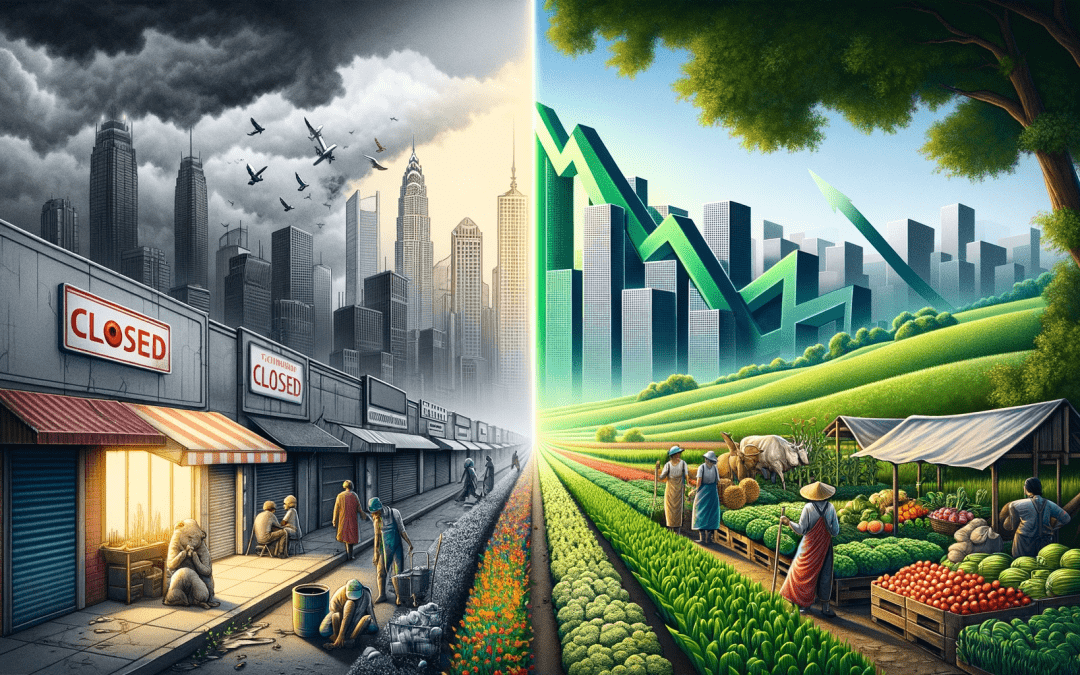
by hhd19 | Nov 19, 2023 | Dashboard
Introduction:
In the dynamic world of economics, trade balances play a pivotal role in determining a country’s financial health. This visualization offers a clear and concise representation of Lebanon’s trade situation over the recent years, focusing on the comparison between the exports and imports of goods and services as a percentage of GDP.
Context:
Lebanon, a country with a rich trading history, has faced various economic challenges exacerbated by political instability and global market fluctuations. Understanding the trade trends is crucial for policy-makers, businesses, and academicians to assess the country’s economic resilience and to strategize for future growth.
These pie charts are a visual summary of the economic challenges faced by Lebanon in terms of trade. They underscore the need for strategic planning and diversified economic reform to build a more balanced and self-sufficient economic structure.
In 2019, the pie chart illustrates that imports considerably outweighed exports, indicating a trade deficit. This imbalance suggests that the country was consuming more than it was producing for external markets.
2020 shows a slight shift with the reduction in imports and a marginal increase in exports. This change could be indicative of various factors, such as a change in economic policy, a response to external economic pressures, or the impact of the global events of that year, like the COVID-19 pandemic.
By 2021, the gap between imports and exports continues to persist, although there’s a noticeable improvement in the trade balance, with exports comprising a larger section of the pie.
Problem:
Lebanon is grappling with a trade deficit.
Solutions:
1- Diversification of Exports: Investing in diverse sectors to increase the range of goods and services for export.
2- Improving Domestic Production: Enhancing the quality and quantity of domestic production to reduce reliance on imports.
3- Trade Agreements: Entering into new trade agreements that favor Lebanese exports or revising existing ones to improve trade terms.
After working on these strategies developing these ideas, and through careful analysis and responsive policymaking, Lebanon can work towards a future where its exports and imports are in a healthier balance.

by amk139 | Nov 19, 2023 | Dashboard
Lebanon’s economy witnessed a significant downturn starting in 2018, with its GDP plummeting from $54.9 billion in 2018 to $23.1 billion in 2021. This sharp decline underscored the urgent need for innovative and sustainable solutions to rejuvenate the nation’s economic framework.
The Crisis in Numbers
The financial crisis in Lebanon manifested in various alarming indicators. The country’s GDP annual growth rate took a nosedive from -1.88% in 2018 to a staggering -21.89% in 2020. This drastic reduction pointed towards a severe contraction in economic activities, investments, and consumption. Further exacerbating the situation was the soaring inflation rate, which reached 154.8% in 2020, eroding the purchasing power of the Lebanese people, destabilizing savings, and deepening economic hardships.
Agriculture: A Beacon of Hope
In the midst of this crisis, a potential solution emerged: leveraging Lebanon’s arable land, which constitutes 13.64% of the country’s total land area. Despite a slight increase in arable land over the past decade, the contribution of agriculture to Lebanon’s GDP witnessed a decline in 2020, signaling an underutilization of this vital resource.
Revitalizing Through Agricultural Enhancement
The proposed solution focuses on enhancing agricultural production. This can be achieved by diversifying crop production, adopting modern agricultural practices, and providing robust support to local farmers. Historically, the agricultural sector has received limited attention from credit bank managers due to perceived risks. Therefore, government incentives and subsidies could play a crucial role in encouraging agricultural growth and exports, thereby aiding in job creation and indirectly boosting the country’s GDP.
Sustainable Practices and Unique Opportunities
Lebanon’s diverse geography and microclimates offer a unique advantage for cultivating a variety of crops. The country’s rich agricultural heritage, featuring culturally significant crop varieties, coupled with sustainable farming practices, enhances the quality and marketability of its produce. The export potential of these unique crops holds promise for stimulating economic growth and fostering regional trade cooperation.
Concrete Steps Forward
Findings suggest that Lebanon’s agricultural sector harbors substantial growth potential, which remains largely untapped. Key recommendations include comprehensive agricultural policy reforms, investment in infrastructure, and promotion of sustainable practices. A collaborative approach involving the government, private sector, and international organizations is essential to effectively implement these recommendations.
Conclusion: A Vision for Recovery
Lebanon stands at a critical juncture where investing in agricultural production and harnessing the potential of its arable land can serve as a cornerstone for economic recovery. This strategy not only aims to enhance the country’s food exports and optimize resource use but also addresses the pressing issues of unemployment and GDP growth.
In essence, Lebanon’s journey towards economic resilience can be significantly bolstered by a strategic pivot to agriculture, tapping into the nation’s inherent strengths and fostering a sustainable and prosperous future.

